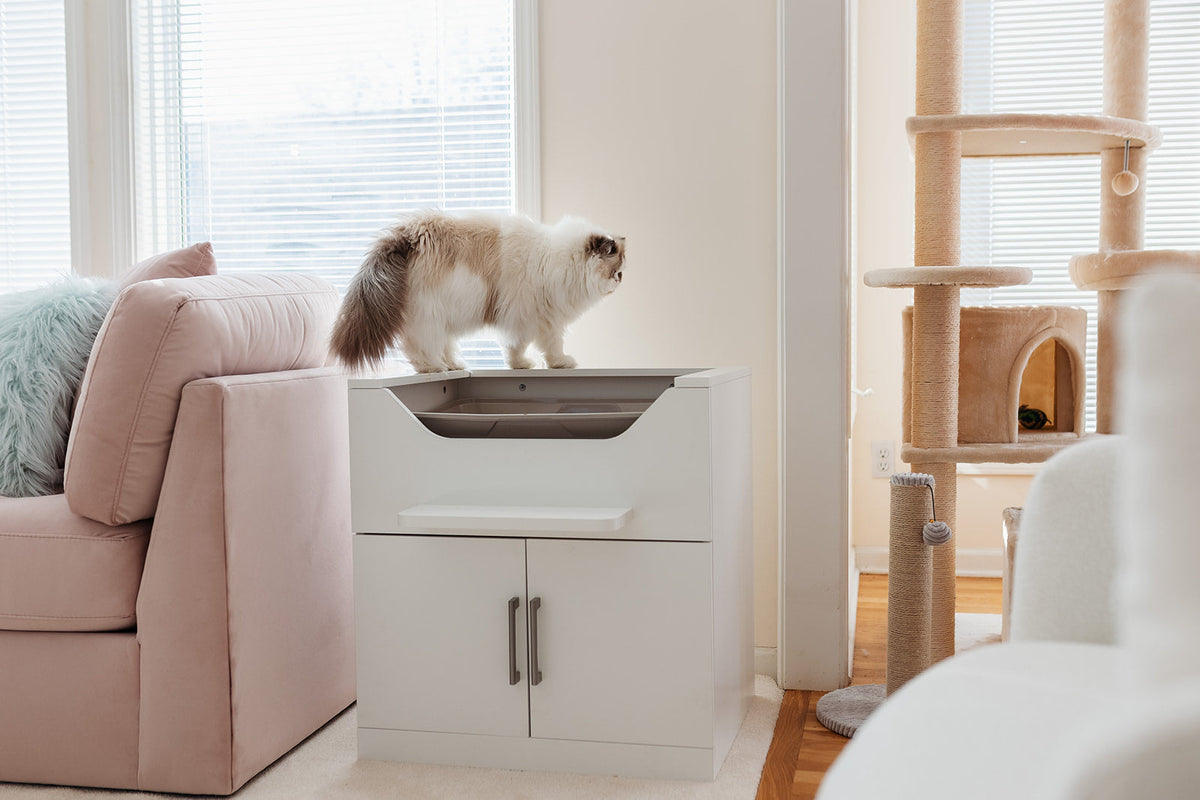

Why Learning How to Cat Proof Your Home Matters
Indoor cats enjoy longer, healthier lives, but your home has its own hidden risks. Cats are curious, agile, and surprisingly determined when it comes to exploring high shelves, getting into tight spaces, or chewing cords. Learning how to cat proof your home protects not only your belongings but your cat’s health and safety.
Whether you’re moving, bringing home a new kitten, or upgrading your pet care setup, this guide walks you through room-by-room safety tips that will help you create a truly cat-friendly home. Cat-proofing doesn’t mean stripping your home of personality or comfort. It means designing a living space that works for both your lifestyle and your cat’s instincts. It’s about blending safety, enrichment, and style to create harmony between you and your feline family member.
How to Cat Proof Your Home: An Important Guideline for Ensuring Your Cat's Safety and Your Sanity
Even the most low-maintenance indoor cats are naturally drawn to explore. They jump onto counters, chew on stringy things, and love to hide in tight places. While these behaviors are instinctual, they can lead to real risks. Even in the safest homes, a curious cat can find danger where you least expect it:
Electric shocks from biting cords
Accidental poisoning from cleaning products or plants
Injuries from unstable furniture or falling objects
Stress from overstimulation or a lack of safe hiding spaces
These hazards can quickly become serious if left unaddressed, especially for young, energetic cats or senior cats with declining senses. Adding protective measures isn’t just about prevention—it’s about supporting your cat’s natural curiosity in a way that’s safe and healthy. An indoor environment with thoughtful structure and supervision can keep your cat active while significantly reducing risk.

Living Room: The Center of Activity
The living room is often where your family—and your cat—spend the most time. This high-traffic area should balance comfort and safety, especially since it's full of electronics, décor, and climbing temptations. Because it's a place of shared relaxation and activity, it's also one of the most important spaces to cat-proof thoughtfully. It’s also where most of your cat’s independent time may be spent, so safety should be proactive. Take a moment to assess what might look like a toy or perch from your cat’s point of view.
Secure TV Stands and Shelves: Cats often leap onto entertainment centers. Anchor furniture to walls and avoid wobbly or stacked objects that can fall.
Tuck Away Cords: Use cord protectors or plastic tubing to keep charging cables, blind pulls, and lamp cords out of reach.
Avoid Candles and Potpourri: Cats can knock over open flames or ingest potpourri oils, which can be toxic.
Add Vertical Territory: Install a cat tree, wall shelves, or window perches to give your cat a safe way to climb and observe.
With a few thoughtful adjustments, your living room can remain a cozy, inviting place that also keeps your curious cat out of harm’s way. Just like the LoftyLoo Raised Litter Box, this shared space can be both stylish and functional while still offering plenty of safe enrichment for your cat. Reinforcing safety in areas where your cat plays and rests ensures peace of mind for the whole household. It also reduces the likelihood of emergency vet visits due to preventable household mishaps.

Kitchen: Tempting but Dangerous
The kitchen is full of enticing smells and risky spots. From open flames to trash bins, it's one of the most important rooms to cat-proof thoughtfully. Sharp tools, open drawers, and low cabinets can all become dangerous playgrounds for curious cats. Unattended food and hot appliances also pose serious risks. Being mindful of what’s left out on counters and where your cat likes to roam can make all the difference.
Keep Counters Clean: Never leave out food, especially items toxic to cats like onions, chocolate, or cooked bones.
Use Latch Locks: Install baby-proof latches on lower cabinets to prevent access to cleaning products or trash.
Stove Safety: Always cover hot burners and never leave the stove unattended. Curious cats can get seriously burned.
Close Appliances: Check your dishwasher, washer, and dryer before closing. Cats love exploring warm, dark spaces.
Watch Trash and Recycling: Keep bins covered or stored in a cabinet to prevent your cat from accessing sharp objects, leftover food, or harmful packaging.
With simple precautions, you can cook and clean confidently while minimizing the risk of accidents for your feline friend. Always be aware of your cat’s habits and favorite hangout spots in the kitchen. Even a quick jump on the counter could result in burns or access to harmful foods. Being consistent with cat-safe routines reinforces boundaries and builds long-term safety habits.

Bathroom: Hidden Hazards
Bathrooms may seem like a safe zone, but they hide many overlooked dangers for your cat. Small items, slippery surfaces, and access to water or chemicals can turn into serious risks if not properly secured. Personal care spaces often contain sharp objects, cleaning agents, and small trinkets that cats may find tempting but harmful. Even a closed toilet lid or shampoo bottle left on the edge of the tub could pose a hazard if knocked over or accessed.
Toilet Lids Down: Prevent drinking or accidental falls by keeping lids shut.
Store Medications: Even small doses of human meds can be fatal to cats. Use closed medicine cabinets.
No Dangling Towels or Curtains: These invite climbing or pulling, which can lead to injury or damage.
Cover Trash Bins: Dental floss, cotton swabs, and hygiene products can all pose choking or digestive risks.
Cats are curious creatures who often explore sinks, tubs, or cabinets—making it important to think like your feline when evaluating safety. Take a few moments each day to scan the bathroom for loose items, open cabinets, or other overlooked hazards. Small changes can go a long way in protecting your cat's health and keeping your space tidy and stress-free. Cats are curious creatures who often explore sinks, tubs, or cabinets—making it important to think like your feline when evaluating safety.

Bedroom: Restful but Risky
Be especially mindful in bedrooms where cats often roam unsupervised. What seems harmless to you might be a tempting danger to your feline companion. Loose threads, dangling jewelry, or spilled medicine can all become unexpected hazards. Cats may also curl up in laundry baskets or drawers, making it important to check before closing anything shut.
Nightstand Checks: Hair ties, rubber bands, and jewelry can be irresistible but dangerous.
Protect Electricals: Power strips and cords should be tucked away or covered.
Under-the-Bed Safety: Block access if it's full of small items or choking hazards.
Keep Windows Secure: Ensure screens are sturdy to prevent falls during curious window watching.
Keep Closet Doors Closed: Cats may wander into closets and get trapped or access unsafe items like sewing kits or plastic bags.
Tidy Up Loose Fabrics: Blankets, scarves, and laundry can pose risks if ingested or used for nesting in unsafe spots.
Simple precautions like these can help your cat avoid accidents and give you greater peace of mind day and night. They also reduce the risk of emergency vet visits caused by everyday household items. Building these habits over time creates a safer and more predictable environment your cat can thrive in.

Home Office or Workspace
Cats love to explore desks and cozy up on keyboards, especially when you’re working. Keeping your workspace safe doesn’t mean excluding your feline—it just means creating boundaries and alternatives.
Hide Cables and Chargers: Cats often chew on cords when bored.
Provide Alternatives: A scratch pad, small perch, or soft blanket can encourage cats to hang nearby without climbing your desk.
Secure Small Items: Paperclips, pins, and rubber bands are all choking risks.
A pet-safe workspace helps you stay focused without constantly worrying about your cat getting hurt or causing a mess.

Enrichment Matters, Too
Safety isn’t just about removing dangers—it’s about replacing them with appropriate outlets. Bored cats are more likely to explore where they shouldn't. Add:
Interactive Toys
Window views or bird feeders outside
Treat puzzles
Scheduled playtime
Cats who feel mentally stimulated and physically engaged are less likely to chew cords or jump onto unsafe surfaces.

Litter Box Placement: Quiet, Clean, Accessible
Where and how you set up your cat’s litter box affect both their comfort and your home’s cleanliness. The right spot can help prevent accidents, reduce stress, and encourage healthy habits. Choose a location that is:
Away from noisy appliances
Easy for your cat to access
Raised or shielded if you have dogs or toddlers
The LoftyLoo is a raised litter box that improves cleanliness and accessibility, especially useful for older adults or those with mobility issues. It also helps prevent dogs from invading your cat’s space. Its elevated design makes it easier to scoop and clean, while giving your cat a dedicated spot they feel safe using.

Final Checks and Maintenance
Cat-proofing isn’t a one-time event—it’s an ongoing process. As your cat grows and your household evolves, regular check-ins help maintain a safe and engaging environment.
Do a Weekly Sweep: Look for new hazards like fallen pills, loose cords, or broken items.
Update as Needed: As your cat ages or your furniture changes, reassess your home.
Vet Consults: Ask your vet about household items that may be unsafe.
These small efforts help prevent major problems and ensure your home continues to support your cat’s safety, curiosity, and well-being.

Final Thoughts for a Safer, Happier Indoor Life for Your Cat and You
Cat-proofing is an act of love. By anticipating your cat’s needs and behaviors, you prevent injuries and stress. Even small changes can make a big difference. Whether you live in a studio apartment or a large family home, a safer environment helps your cat feel secure, enriched, and right at home.
Your cat deserves a space that supports their natural behaviors safely. And you deserve peace of mind. Start with one room, and build from there. The result? A cleaner, calmer, and more cat-harmonious home—with fewer messes and a happier feline by your side.
Want to improve both safety and daily care? Try LoftyLoo—the raised litter box designed to keep your cat clean, your home organized, and your routine easier.


